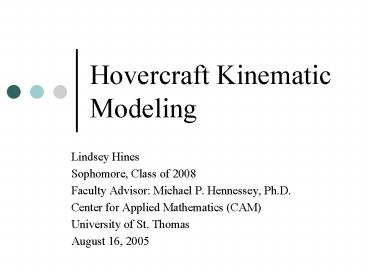Hovercraft Kinematic Modeling - PowerPoint PPT Presentation
1 / 20
Title: Hovercraft Kinematic Modeling
1
Hovercraft Kinematic Modeling
- Lindsey Hines
- Sophomore, Class of 2008
- Faculty Advisor Michael P. Hennessey, Ph.D.
- Center for Applied Mathematics (CAM)
- University of St. Thomas
- August 16, 2005
2
Outline
- Parameter Estimation
- Simulations
- Realism
- Stability
- Conclusions
- The Problem
- Hovercraft
- Developing the State-Space Model
3
The Problem
- Aim to create an accurate mathematical model of
hovercrafts motion - Reasons
- to explore an interesting mechanical system
- to achieve correlation between the computer-run
simulations and real life - to form a foundation for further applications
- to prepare material for Dr. Hennesseys J-term
kinematics class
4
Hovercraft
- Lift fan and skirt allow hovercraft to ride on
cushion of air - Rear fans provide force necessary for forward
motion and direction change - Can be regarded as a 2-D rocket
5
Developing the State-Space Model
- state-space vector
- force input from thrusters
- friction parameters
- inertia parameters
- geometric parameter
6
Equations of Motion
7
Parameter Estimation
- Geometric parameter ( ) simple to determine
- Maximum force ( ) imparted by rear fans
measured by spring gauge - Mass ( ) measured by electronic scale
- Determining the translational ( ) and
rotational ( ) coefficients of viscous
friction and the moment of inertia ( ) was more
difficult
8
Viscous Friction Experiment
- Only incorporating viscous friction
- Viscous friction coefficients and
estimated - Hovercraft brought to top speed then allowed to
coast to a stop - Time to stop measured
- similar to except involves rotational
motion
vo
9
Moment of Inertia Experiment
- No simple, convenient shape for calculation
purposes - Necessary to find moment of inertia experimentally
Two supporting cables
10
Simulations
- Matlab
- Script files
- Simulink
- Open loop
- No active control feed in values and see where
the hovercraft goes - Input values ( and ) are parameterized by
blocks of time where on/off is represented by the
values of and 0.
11
- Hovercraft Subsystem
12
Simulation Block Diagram
13
Simulink Configuration
14
Is this Realistic?
- Basic maneuvers the test of common sense
- Different initial conditions,
- Left/right turns,
- Straight-line motion
- Obstacle course simulations
- Requires more precision
- Two different courses run in Matlab
- Fan inputs reenacted on remote control by
blindfolded individual
15
Obstacle Course 1
Finish
Start
16
Obstacle Course 2
Start
Finish
17
Video Clips
- Example of the difficulty directing hovercraft
- Direction and speed
- The ideal run
- Obstacle course 1 human judgment and control
18
Stability
- Linear stability analysis, open loop system
- small
- Marginally stable
Linear model
Six Eigenvalues
19
Conclusions
- Hovercraft can be modeled in Matlab and Simulink
more accuracy necessary - Stabilization is possible
- Completing stabilization
- Creating more accurate feedback for closed loop
sensors
Future Work
20
Questions?































